Class Summary
Mrs. Tommaso's
Second Grade Class!


Math- Unit- 3 Numbers Within 1000
This unit extends students' understanding of adding and subtracting within 100
The major themes are:
- The value of a digit in a number depends on its place in the number. Knowing the value will help you determine the total value of a number and will help you read, write and compare numbers.
- Mentally add 10 or 100 to numbers or subtract 10 or 100 from numbers.
- Breaking apart numbers as a strategy for adding or subtracting.
Writing- Opinion Writing-
Students will write about books they love to read in ways that will persuade others to love them as much as they do. Students will form opinions about the books they read, thinking deeply about characters. Students will learn to state clear opinions and to support these ideas with evidence.
Reading- Nonfiction
Second graders will dive deep into the world of information. Students will discover unique ways to stop and jot about their new learning. They will also learn how authors use various structures to help them learn about the topic. Students will ask and answer questions about what they are reading.
Fundations-Unit 6-9 Students will be introduced to several different syllable types
- V-E- This syllable has a vowel, then a consonant than an e. The first vowel is long and the e is silent.
-Open syllable- This syllable has only one vowel which is the last letter in the syllable. The vowel is long.
- R-controlled syllable- this syllable contains a single vowel followed by the letter r. The vowel is neither long or short it is controlled by the R. Students will read and spell words with the r-controlled sound.
Science-Works of Water- In this unit, students explore how water shapes the Earth's surface. Students construct and use models of mountains to demonstrate that water flows downhill, and in the process, transforms huge rocks into the tiny grains of sand we find at the beach. Students also construct and use model hills to determine the causes of erosion, and to design solutions to problems caused by erosion.
Last modified by Mrs. Tommaso on Monday, March 4, 2024

 Receive Notifications
Receive Notifications Contact Us
Contact Us